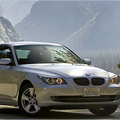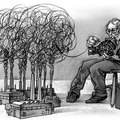
The original R-110 Travelall of 1953-54.
THE question of exactly which automaker created the muscle car or just what company gave birth to the minivan may never be answered satisfactorily. The origins of the sport utility vehicle seem to be more certain, however.
In 1953, International Harvester, a manufacturer better known for its farm tractors and commercial trucks, introduced the Travelall, a truck-based passenger wagon. True, the Chevrolet Suburban had a similar layout (and a name that dates to the 1930s), but the Suburban didn’t acquire four-wheel drive, a hallmark of the S.U.V. category, until 1960; the Travelall was available with four-wheel drive by 1956.
Dodge’s Town Wagon wasn’t offered with four-wheel drive until 1957. Willys, Kaiser and later American Motors sold civilian versions of the Army jeep, but these spartan vehicles were hardly the forebears of the modern soccer-mom S.U.V.
International’s head start was little help in the long run. By the time S.U.V.’s became must-have accessories for suburban families, the company had decided to focus its efforts on commercial vehicles and was long gone from the consumer market. Chevy, Dodge and Jeep still sell utility vehicles, of course, and have earned tidy profits from the category that International defined.
Now producing buses, large trucks and diesel engines under the Navistar name, International traces its roots to the invention of the reaper by Cyrus McCormick in 1831. In 1907, the company began production of the Auto Buggy, a versatile passenger car with a removable back seat that let it serve double duty as a pickup. Before long, it was producing the Auto Wagon from the same basic structure, complete with a bed that could haul an 800-pound load.
International’s century of truck making is chronicled in a colorful tribute published in June, “Milestones in the Company That Helped Build America” (Graphic Arts Center Publishing, $60). Historic photographs and reproductions of advertisements illustrate the company’s close ties to the farm economy and its contributions to the country’s growth; by 1910 International was the fourth-largest company in America by the value of its assets.
Farm implements and work trucks of all sizes and shapes helped International to prosper. A wide range of specially bodied vehicles, from armored cars to gasoline tankers, were built on International chassis. Mainstream pickups delivered industry’s goods, and one of its school buses became an icon of popular culture as the psychedelic Furthur bus of Ken Kesey’s Merry Pranksters.
But taking the reputation for ruggedness to a new market of private buyers was another challenge altogether. With advertising that emphasized four-wheel-drive practicality, International wisely initiated a marketing campaign directed at suburban families rather than at farmers or tradesmen. Unfortunately, the timing wasn’t ideal.
Al Ries, chairman of a marketing strategy firm and a prolific author of business books, has said that “strategy and timing are the Himalayas of marketing; everything else is the Catskills.” International’s rugged Travelall — and later the Scout — may have been capable of tackling the Himalayas, but from a timing standpoint, they never left the Catskills.
Even if its timing was off, International’s strategy was prescient. Travelall marketing campaigns often featured women; later ads pictured preppy couples loading their Travelall with furniture at a New England antiques shop.
According to Dee Kapur, president of the International Truck Group at Navistar, no one is really sure how or why the Travelall was approved for production. Although it seems incredible today, there was no market research or shopping-mall focus groups, just a hunch that a need might exist.
According to Mr. Kapur, International Harvester thought that it could hit on a winning formula by infusing the DNA of its rugged commercial trucks into a passenger vehicle. And in fact, the Travelall started out as a modified R-Series commercial panel truck with side windows and a new tailgate design. It sold moderately well and was on the market from 1953 until 1975. Its only major restyling took place in 1969.
Roughly comparable in size to today’s Suburban, the first Travelalls were two-door models. In 1957-61, they had a third door on the passenger side; later, all Travelalls came with four doors. Ansel Adams used one to travel the United States, often photographing his magnificent landscapes from a custom-built platform on the roof.
Collectors seem to prefer the vintage look of the first series, but it is unusual to see Internationals of any kind at collector car auctions.
Charles Kuhn, a Chicago classic-car dealer, said that was a result of rather low survivorship. “Most probably lived long, hard lives in the hands of tradesmen and outdoors types and were just used up well before there was any thought about collectibility,” he said.
Still, Mr. Kuhn said that a restored Travelall is truly a usable collector vehicle that makes a much different statement about the owner than a new Grand Cherokee or Explorer.
The Travelall was followed by the smaller Scout in 1961. The Scout came only with two doors in various hardtop and soft-top configurations. In size and concept, it was similar to the Ford Bronco II of two decades later. But according to Mr. Kapur, everything was built to a more rugged standard, as would be expected from a company building commercial trucks.
If a vehicle is a reflection of the owner’s personality, then Chris Chelios is the archetypal Scout owner. Mr. Chelios — a defenseman for the Detroit Red Wings and a durable veteran of 24 N.H.L. seasons — has owned seven Scouts. He currently has two, one of which stays at his off-season home in California.
Mr. Chelios enjoys their tough and trouble-free nature. “I can leave them sitting for a long time, and they always start right up,” he said. “The one in California hasn’t had its top up in 12 years. Their design makes them better-looking when the top is down.”
Mr. Chelios said that finding parts was not an issue. Although Navistar no longer supplies them, various specialists have filled the void.
According to Mr. Kapur, International’s dealer network, and a recession, were responsible for the company’s decision to leave the passenger vehicle market. Scouts and Travelalls were sold alongside commercial trucks through International Harvester’s dealers. Most were in rural areas rather than in the urban and suburban markets that International sought to crack.
In addition to its large trucks, Navistar today sells the XT series of gargantuan pickups for extra-heavy-duty service. These could provide the platform for a supersize S.U.V.
Mr. Kapur said that it was not impossible that Navistar might return to claim part of the market it pioneered. “If we do, it will certainly be something different and worthy of our heritage in the truck industry.”
International Harvester’s departure from the consumer truck market in 1980 came years before vehicles like the Ford Explorer and Jeep Grand Cherokee changed the suburban landscape. Had it been able to hold out a while longer, International, a company with a real heritage and a history in rugged commercial trucks, would probably still be a player in an S.U.V. market successfully populated by such unlikely truck makers as Porsche and BMW.




